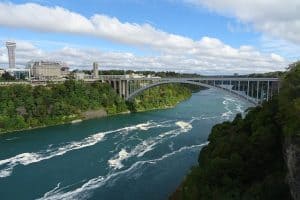 October 25, 2017 – Canada’s Immigration and Refugee Board (IRB) has accepted nearly 70 per cent of the asylum claims made by people who crossed the border from the U.S.
October 25, 2017 – Canada’s Immigration and Refugee Board (IRB) has accepted nearly 70 per cent of the asylum claims made by people who crossed the border from the U.S.
Some 408 of 592 finalized claims have been accepted from people who crossed the border between March and September. A further 92 cases are at the appeal stage after being rejected.
The finalized cases are only a fraction of the more than 15,000 claims received from people who crossed the border from the U.S. to Canada irregularly.
Read More
Ministers Grilled on Reaction to Canada’s Asylum Seeker Surge
Canadians Equally Divided on Whether to Welcome U.S. Asylum Seekers
Ottawa’s Information Campaign Chokes Flood of Asylum Seekers from U.S.
The spike was widely thought to be caused by a combination of Donald Trump’s attempted crackdown on immigrations, and a wrongly-held belief that Canada would accept everyone.
The IRB has a growing backlog of 40,000 claims waiting to be heard, with an annual processing capacity around 24,000 per year. The waiting time for a hearing is currently 16 months, a number that is only set to rise, according to officials.
Immigration Minister Ahmed Hussen said the IRB was currently the subject of a third-party review, when he was questioned on the backlog during a meeting of the Standing Committee on Citizenship and Immigration on Thursday, October 5.
He said the backlog issues were not just about pumping more money in the organisation, but also about overhauling its structure and modernising the way the system is administered.
A dedicated team of 17 IRB officials set up to hear the illegal border crossing cases is aiming to hear 1,500 cases by the end of November 2017. After that, the cases will be absorbed into the normal workflow of the board.
Minister Hussen was grilled on the government’s response to the surge in mainly-Haitian asylum seekers crossing the border illegally from New York to Quebec during the Standing Committee hearing.
Numbers spiked to 300 a day during July and August, from the normal 20 to 30, but Hussen was adamant “it was not a crisis”.
Initial Hearings
Extra capacity at Lacolle, Montreal and Cornwall, Ontario centres and the redeployment of Immigration, Refugees and Citizenship Canada staff allowed the number of initial hearings to be increased from 32 to 200 per day.
Hussen said the processing times for initial asylum claims dropped from five to seven months to five to seven days to cope with the influx. Those claiming asylum were also given fast-tracked work permits in 30 days so they could support themselves while waiting for an IRB hearing.
The minister also detailed how Canada has gone about correcting the false information that resulted in so many Haitian asylum seekers arriving at the border.
Hussen attended a meeting in New York and found that some major refugee and immigration organisations needed to be brought up to date on Canadian policy on asylum seekers.
Goodale Faces Questions on Security
Public Safety Minister Ralph Goodale also attended the Standing Committee hearing, facing questions on whether security had been compromised as a result of reduced initial processing times.
It was put to him that with initial interview times dropping from eight to two hours, the thoroughness of checks had to have been compromised. He firmly rejected this.
“The implication that border security and safety has been compromised is absolutely wrong,” Goodale said.
Goodale said the degree of difficulty of the cases faced was small, in terms of border crossers being deemed a risk to the health and safety of Canadians.
The less than 1 per cent of cases where serious criminality was discovered rendered the border crosser ineligible to begin the process of claiming asylum.
Non-governmental organizations and UN Refugee Agency officials made regular checks and were very positive on how the situations was being dealt with, Goodale reported.
Stream Reduced to A Trickle
The stream of asylum crossing the Quebec border reduced to a trickle in September, with under 50 per day arriving.
The government information campaign combined with the start of the school year, is believed to be behind the dramatic reduction in numbers.
It supports the argument that the majority of current asylum seekers are in fact economic queue jumpers, seeking a faster entry into Canada.
A federal-provincial taskforce was formed in response to the situation, including Hussen, Goodale, and Quebec Immigration Minister Kathleen Weill.
Safe Third Country Agreement
There have been several calls for Canada to suspend the Safe Third Country Agreement with the U.S., which says an asylum seeker must make their claim in the first country to which they arrive. The agreement is the reason why those coming from the U.S. are electing to cross the border at remote locations, with the aim of getting arrested and entering the Canadian immigration system. Such individuals would otherwise not qualify to submit a claim as the Safe Third Country Agreement would prevent them from doing so.
However, with negotiations currently ongoing for the renegotiation of NAFTA, Canada will not want to do anything to harm its bargaining position with the USA.
Interested employers: Kindly contact us here to receive further information.
Interested candidates: Find out whether you qualify to Canada by completing our free on-line evaluation. We will provide you with our evaluation within 1-2 business days.
Read more news about Canada Immigration by clicking here.




